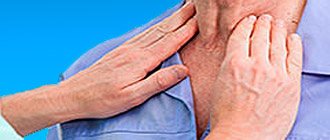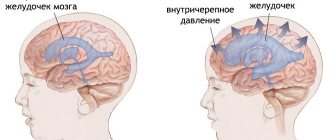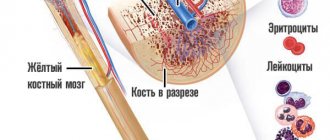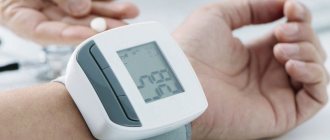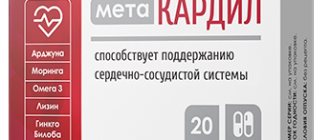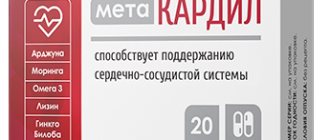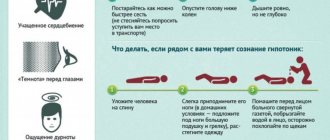Every person has eye pressure, just like blood pressure.
This is the fluid pressure inside the organs of vision. With a persistent increase in IOP, it is not possible to avoid glaucoma or other dangerous diseases.
Normally, eye pressure should vary between 10-20 mmHg. Art. When conducting diagnostics, it is important to take into account the normal parameters of the device itself; the indicators will differ in different tonometers.
When IOP increases, discomfort, headache and other symptoms appear that many patients are not able to identify. This condition requires urgent treatment. With a persistent increase, the patient faces not only glaucoma, but also a complete loss of visual perception.
Drops
Eye drops are used to improve the outflow of intraocular fluid. They improve tissue nutrition and help quickly lower IOP.
For ocular hypertension, cholinomimetics, beta blockers, combination medications, drugs with latanoprost, vitamins and omega-3 fatty acids are prescribed.
The best drops to lower IOP:
- Xalatan improves fluid outflow. The medicine is indicated for patients with ophthalmotonus and open-angle glaucoma. Xalatan is a prostaglandin F2-alpha analogue.
- Glauprost is an antiglaucoma medication. The active substance is latanoprost. Glauprost reduces ocular hypertension by 31% from baseline. This drug does not begin to act immediately, the effect appears 3-4 hours after use. In isolated cases it causes burning, tingling and severe itching. This is due to an allergic reaction to the components of the product.
- Travatan is a highly selective prostaglandin receptor agonist. Reduces ocular hypertension by increasing aqueous outflow through the trabecular meshwork. The maximum effect of the drug is achieved 2 hours after use. Travatan is contraindicated for use in children under 18 years of age, pregnant women and women during lactation.
- Betoptic is used as monotherapy or in combination with other medications. Eye drops are instilled 10–15 minutes before applying ointments. Betoptik should be used with caution in diabetes mellitus and pheochromocytoma.
- Timolol is a non-selective beta blocker. The drug leads to a decrease in elevated and normal IOP. Timolol reduces the secretion of aqueous humor and at the same time restores its outflow.
- Aceclidine belongs to the group of cholinomimetics. The medicine increases tone and causes increased contractions of the intestines, urinary tract and uterus, so it should be taken with caution by persons with diseases of these organs.
- Carbacholine is more active and has a longer lasting effect. The medication increases tone and reduces ocular hypertension. Carbacholine can cause fever, nausea, and bradycardia. Symptoms disappear after reducing the dose.
- Pilocarpine and Brimonidine belong to the group of sympathomimetics. These medications create the appearance of catecholamine activity, resulting in a decrease in IOP. Medicines have risks, they are not recommended for use if you are prone to arrhythmia and with high blood pressure, they will lead to deterioration and hyperemia of the mucous membrane of the visual organs.
Forecast
If the increase in ophthalmotonus is caused by fatigue and the patient quickly took the necessary measures, then the prognosis is usually positive. In the absence of any action, the disease will develop and glaucoma may appear. Patients with this diagnosis have a 75-80% chance of recovery if they go to the hospital in a timely manner. In other cases, complete blindness often occurs in one or two eyes at once.
Treatment at home for eye pressure is possible, but only under the supervision of a doctor and after a detailed examination. After completing the course of therapy, you should definitely see an ophthalmologist.
He will check the ophthalmotonus and, if necessary, recommend other methods to solve the problem.
Pills
This form of drug treatment is rarely used. Taking tablets showed the least effectiveness in reducing IOP compared to other drugs.
It is possible to remove ophthalmotonus with their help, but it will take more time. If you need quick results, use eye drops. Unlike tablets, they do not affect the stomach and intestines. The drops bypass the digestive tract, thereby causing less harm and causing virtually no side effects.
Acetazolamide is used to reduce ocular hypertension. The dosage, frequency of use and duration of treatment are determined by the attending physician after a thorough diagnosis of the patient’s visual system. Acetazolamide is a carbonic anhydrase inhibitor. The drug slows down all reactions in the body. The same process leads to the relief of hypertension.
Brinzolamide suspension is also prescribed. The drug is also an inhibitor. The ophthalmic suspension is absorbed to some extent systemically.
Diagnostics
To determine the cause of the disease and prescribe therapeutic measures, it is necessary to undergo a full examination in a hospital setting. Eye hypotony is diagnosed using:
- visometry;
- perimetry;
- biomicroscopy;
- ophthalmoscopy;
- tonometry;
- echography;
- gonioscopy.
After receiving all the results, a final diagnosis is established and appropriate treatment is prescribed. Until the results are obtained, the patient is prescribed medications to relieve symptoms.
Patients with diabetes are prescribed a general blood and urine test and a blood test for sugar. Consultation with a therapist and endocrinologist is required.
Treatment with folk remedies
External means
With the help of traditional methods of treatment, the patient’s condition can be alleviated. Medicinal plants are used to prepare eye drops. You should first check whether the patient has allergies. The test is performed on the inside of the elbow.
Solutions are used for rinsing, lotions and eye drops. For topical use use:
- Aloe juice. You will need 2 fleshy leaves. Cut them into small pieces, pour boiling water over them and put on low heat. Boil aloe for 20 minutes, cool and strain. The eyes are washed with this decoction 2 times a day for 2 weeks. A cotton swab is soaked in the solution, and excess liquid is squeezed out. Wipe your eyes from the outer corner of the eye to the inner.
- Grind the onion in a blender or finely chop with a knife. Squeeze out the juice using sterile gauze. The resulting mixture is diluted with water in a 1:1 ratio. Instill the medicine into the eye up to 3 times a day for 7 days.
- Mix mashed potatoes with 1 tsp. 6% vinegar, put a gauze napkin. Wrap in gauze and apply to closed eyelids. Hold for 10 minutes.
Doctors recommend using a contrast shower. This should be done to tone the blood vessels. A contrast shower helps reduce intraocular pressure.
Means for oral use
Home remedies for internal use can help relieve high eye pressure. They can be taken by most patients who have contraindications to medications.
Taking medications is contraindicated if you have a hypersensitivity to a particular herb.
The following home remedies are used for internal use:
- In a clean container, mix 3 tsp. dried calendula flowers, pour 500 ml of boiling water and leave for 2 hours. When the medicine has cooled, strain. Use the drug ½ glass up to 4 times a day. This medicine can be used as a lotion.
- Grind 3 tbsp. walnut leaves, 2 tsp. rosehip flowers, 1 tsp. rosehip root and a small piece of aloe. Combine the ingredients, pour 0.5 liters of boiling water, leave for an hour. Use the prepared product 15 ml per day before meals. Store the medicine in the refrigerator for no longer than a week. The course of treatment lasts 20 days, then a break and a second course of therapy are required.
- The medicinal properties of woodlice help to cope with increased IOP. You will need 8 kg of medicinal plant. Squeeze 6 liters of juice from it using a juicer. Add 600 grams of alcohol and store the composition in the refrigerator. Take the medicine 50 g 20 minutes before meals. Dilute with water in a 1:1 ratio. Drink for 2 months.
- A herbal mixture of 1 tbsp will help reduce eye pressure. l. nettle, horsetail, string, flax, plantain and lingonberry, 3 tbsp. l. St. John's wort, 2 tbsp. l. rowan and rosehip. Grind the herbs, pour 500 ml of boiling water. The medicine should be infused for 3 hours. Strain the medicine and take ½ cup 3 times a day.
Take medications at the same time as drops and tablets prescribed by the doctor. You cannot use traditional methods without consulting a doctor.
Course of therapy at home
Increased eye pressure is often of a secondary nature. It may manifest itself due to other diseases, for example, a tumor, an injury, or a pathology characterized by an inflammatory process. In this case, first you need to eliminate the main problem, since it will not be possible to relieve eye pressure at home without this. As the primary cause is treated, ophthalmotonus gradually normalizes.
In other cases, increased intraocular pressure can be cured using the following methods:
- drug treatment;
- folk recipes;
- physiotherapy.
It is difficult to completely remove high eye pressure using folk remedies, so they must be combined with medications.
To improve the effect and relieve stress on the eyes, it is better to combine the main treatment with gymnastics, especially during sedentary work. However, experts recommend consulting with a doctor before starting a course of therapy at home. He will tell you how to treat eye pressure without harming yourself, and will recommend the most effective techniques.
Gymnastics for the eyes
Special exercises developed by experienced ophthalmologists help reduce IOP. To achieve a positive result, perform gymnastics at least 3 times a day.
Eye exercises:
- frequent blinking for 1 minute;
- turning the eyes clockwise and counterclockwise - perform with closed and open eyelids;
- transferring the gaze from a distant object to a near one;
- drawing geometric shapes, letters and numbers with the eyes.
Gymnastic exercises not only help a person reduce intraocular pressure, they improve the nutrition of eye tissue. They improve the functioning of the visual system, allowing oxygen and beneficial nutrients to better penetrate the tissues of the eyeball.
In addition, gymnastics prevents the development of refractive errors and accommodation spasms, which cannot be avoided as the body ages.
Prevention
Disturbances in changes in intraocular pressure can be avoided if you follow the recommendations of ophthalmologists. These include:
- Annual preventive examination. The date is set by the doctor, if the blood pressure rises slightly and is controlled with medications, it is repeated every six months. If the condition worsens, additional examinations are prescribed.
- Diet plays an important role in the functioning of the visual system. The daily menu should include fruits, vegetables and a sufficient amount of greens. It is not recommended to consume fast food products. Eat sea fish and carrots once a day. Blueberries have a particularly beneficial effect.
- If it is not possible to change professional activities, it is necessary to reduce the load on the visual organs. Take breaks every 45 minutes when working at the computer for long periods of time. During a break, do eye exercises.
- Regular exercise will help preserve vision and reduce IOP. If you don’t have time to go to the gym, do it at home. If illnesses prevent physical activity, walk in the fresh air more often and walk at least 2–3 km per day. Fresh air has a positive effect on general and eye pressure.
Symptoms of high eye pressure
Consistently high eye pressure is a sure sign of glaucoma. Typically, pathological changes occur in people over 40 years of age. Women get sick more often than men, this is due to the hormonal characteristics of the female body.
Signs of increased eye pressure may include:
- redness of the eyes;
- discomfort when looking at the light, the appearance of spots or veils before the eyes;
- painful sensations in the eyes, a feeling of fatigue even with slight exertion;
- decreased visual acuity at dusk;
- limiting the field of view;
- acute pain in the temples and dizziness.
Increased eye pressure can be caused by various reasons. Most often, the pathology occurs against the background of hypertension, endocrine disorders, liver and heart diseases, and severe menopause.
An increase in eye pressure is fraught with the risk of decreased visual acuity, worsening headaches, and hypertension. Normalizing eye pressure is the main task that an ophthalmologist sets for himself in treatment. The patient may need the help of a neurosurgeon, therapist, or endocrinologist.


